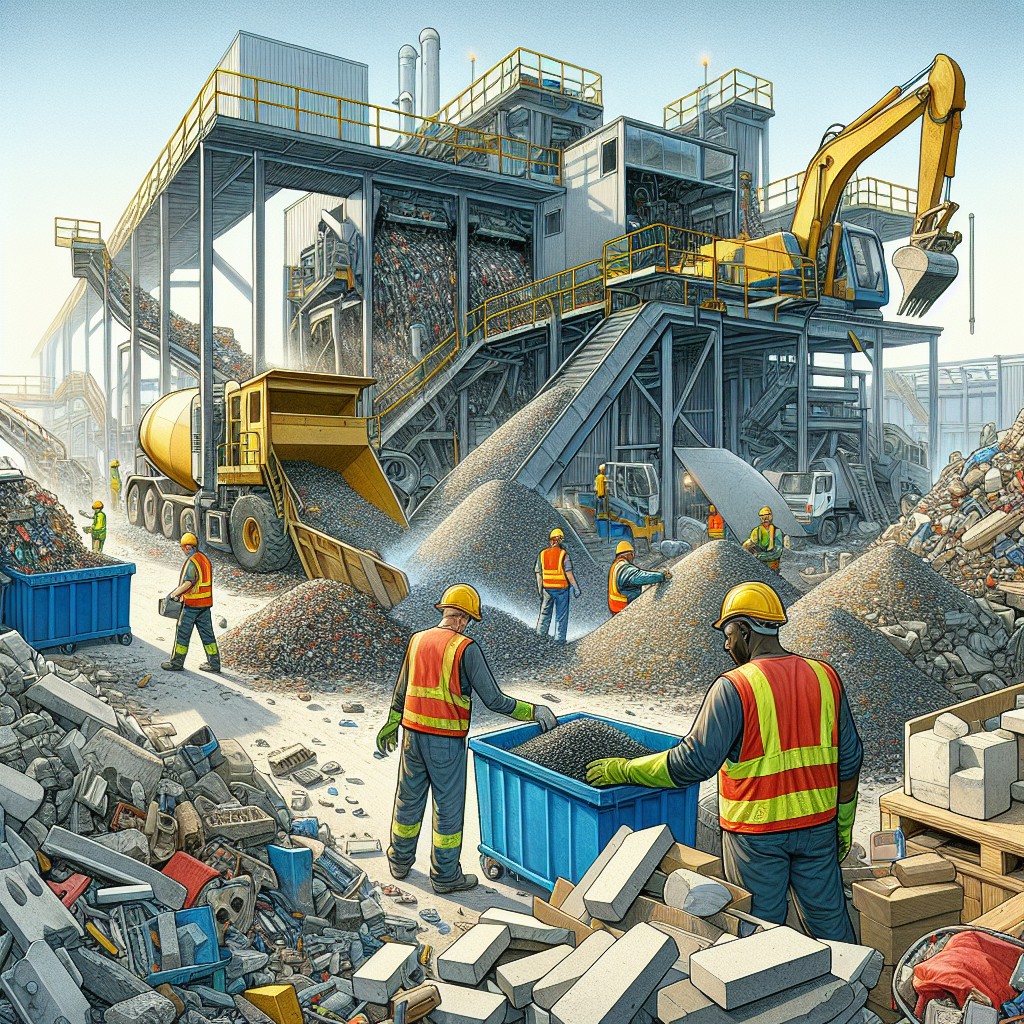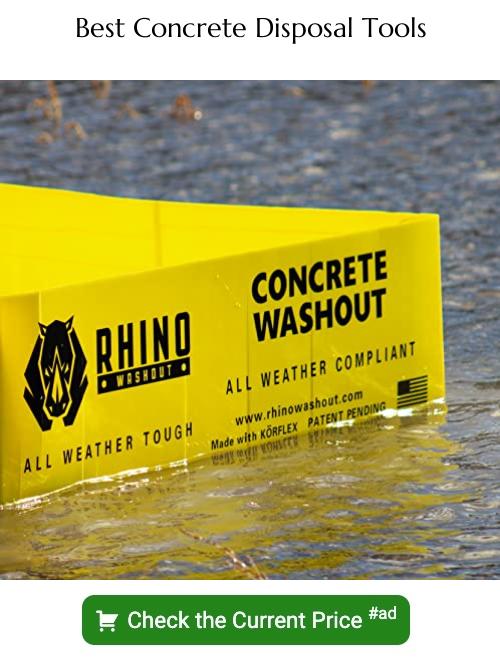Last updated on
Exploring free concrete disposal options becomes crucial when undergoing a home renovation because it aids not only in maintaining a clean workspace but also plays a significant role in environmental conservation.
Key takeaways:
- Local municipalities often host hazardous waste drop-off events for free concrete disposal.
- Recycling centers and construction material facilities accept concrete for recycling.
- Local landscaping companies may accept clean concrete rubble.
- Online platforms like social media groups and marketplaces can connect you with individuals in need of concrete.
- Consider repurposing concrete for DIY landscaping projects.
Local Options for Free Concrete Disposal

Exploring the avenues for discarding concrete without incurring costs begins right in your community. Many municipalities host hazardous waste drop-off events where you can dispose of materials like concrete for free. Contact your local public works department for event schedules and regulations.
Recycling centers dedicated to construction materials often accept concrete, ensuring it gets a second life in new construction projects. A quick online search or a call to your county’s waste management office can point you toward nearby facilities.
Reach out to local landscaping companies; they sometimes accept clean concrete rubble for use in various projects. Some may even offer pickup services, although these might not always be free.
Using social media community groups or neighborhood apps can also be effective. Offer your leftover concrete to those undertaking home improvement projects or garden renovations.
Remember to gauge the size of your concrete waste against the disposal options available. Smaller quantities are easier to manage and more likely to be accepted for free.
Identifying Local Construction and Demolition Recycling Facilities

To pinpoint recycling facilities that handle construction and demolition materials, start by exploring your municipality’s waste management website. Here, you’ll usually find a directory of authorized centers. If this comes up short, the Construction & Demotion Recycling Association (CDRA) offers a searchable database of recyclers across the country.
As you make your inquiries, confirm if they accept concrete, as some facilities may have restrictions. They might require that the material be free from contaminants such as metal, trash, or wood, so be prepared to sort and clean your concrete beforehand.
Many facilities offer drop-off services, while others might provide pick-up, which could be fee-based. To ensure a smooth process, check operational hours, drop-off procedures, and if you need to schedule an appointment.
Engage with local contractors as well. They often have insights into the most efficient and cost-effective recycling facilities in your area due to frequent utilization.
Lastly, look into app-based services that connect you to nearby recycling centers. Some apps even streamline the drop-off process and provide up-to-date information on facility requirements and restrictions.
Contacting Building Materials Supply Companies
Often, companies that supply building materials also manage waste products from construction sites, including concrete. Reaching out to these suppliers can provide you with insight on where you can dispose of your concrete at no charge. Some companies may repurpose old concrete for new building projects or have partnered with recycling facilities.
- Inquire about partnership programs: Some suppliers may work with recycling plants and can direct you to locations where concrete is accepted free of charge.
- Ask about drop-off policies: If a supplier accepts concrete, they may have specific times and conditions for drop-offs.
- Explore material exchange opportunities: Occasionally, these companies offer services that match individuals disposing of materials with others who need them, potentially avoiding disposal costs altogether.
- Consider the logistics: If a company can accept your concrete, ensure you have the means to transport it to their location safely.
By engaging with local supply companies, you may find a cost-effective and environmentally responsible solution for disposing of your unwanted concrete.
Finding Nearby Landfills and Transfer Stations
When searching for landfills and transfer stations to take your concrete waste, you’re in luck as many of these facilities readily accept construction materials for recycling or proper disposal. To kick-start the process:
- Utilize online databases like Earth911 or RecycleNation to search for sites accepting concrete. You can simply input your material type and ZIP code for a list of nearby options.
- Check with your local Department of Public Works or Environmental Services; they can provide information on public facilities.
- Inquire directly with regional waste management companies — they often operate or know of suitable disposal sites.
- Be sure to call ahead to verify acceptance of concrete material, hours of operation, and any fees associated with disposal.
- Look for specialized facilities that recycle concrete into new building materials, often offering more sustainable disposal routes.
By investigating these avenues, you’ll find a disposal solution that fits your project’s needs while ensuring you stay within local regulations for waste management.
Leveraging Online Marketplaces for Concrete Giveaway
Online marketplaces have become a valuable resource for disposing of unwanted materials, concrete included. Platforms like Craigslist, Freecycle, or even local Facebook groups can connect you with individuals or companies in need of concrete for various projects, such as walkways, landscaping, or small building tasks.
When using these services:
- Be precise in your description: Detail the amount, type, and condition of the concrete you’re offering.
- Include photos: Visuals help potential takers assess the suitability for their projects.
- Mention any requirements: Specify if the taker needs to handle the transport or if any help will be provided.
- Communicate clearly: Respond promptly to inquiries and provide complete pick-up instructions.
By providing concrete for free, not only do you reduce disposal costs, but you help others obtain materials they need, fostering a sense of community and sustainability.
Methods for Concrete Disposal and Recycling
Renting a tailored dumpster for concrete debris is a practical approach, ensuring efficient disposal and often including the cost of recycling in the service fee. Local laws may dictate specific requirements, so it’s advisable to consult with the rental company about the types of materials allowed.
Utilizing platforms such as Craigslist or Freecycle can connect you with individuals seeking free concrete for projects, effectively diverting waste from landfills. This mutually beneficial exchange underscores a growing trend in sustainable material reuse.
Converting unwanted concrete into landscaping features like pavers, stepping stones, or garden borders is creative recycling. DIY enthusiasts can repurpose concrete waste, reducing disposal needs and enhancing outdoor spaces.
Always prioritize personal safety and environmental regulations when engaging in any disposal or recycling activity. Proper gear and adherence to guidelines ensure that these methods not only eliminate waste but also contribute positively to environmental sustainability.
Renting a Dumpster Specifically for Concrete Waste
When the quantity of concrete waste is significant, renting a dumpster can be an efficient solution. It’s crucial to understand that dumpsters designated for concrete are different from regular waste dumpsters due to weight restrictions and recycling process requirements.
Here are some actionable points to consider when opting for a dumpster rental:
- Size Matters: Choose a dumpster size based on the volume of concrete waste you have. Smaller projects might require a 10-yard dumpster, while larger projects could need a 20-yard or larger.
- Weight Limits: Concrete is heavy, and dumpsters have weight limits. Inquire about the weight capacity to avoid additional fees for overloading.
- Clean Load: Ensure that only concrete waste is placed in the dumpster, as mixing it with other debris may violate rental terms and affect recycling.
- Recycling Efforts: Verify that the rental company recycles concrete. This not only supports sustainability but can sometimes lower the rental costs.
- Permit Requirements: Depending on your location, you may need a permit to place a dumpster on public property. Check local regulations beforehand.
- Access and Placement: Ensure the drop-off location is accessible for the delivery truck and that the dumpster’s placement doesn’t obstruct traffic or violate local codes.
- Rental Duration: Determine how long you need the dumpster and discuss the rental period terms to ensure it aligns with your project timeline.
By considering these points, you can efficiently manage your concrete disposal needs while adhering to environmental guidelines and potentially saving on costs.
Checking Craigslist or Freecycle for Disposal Opportunities
Utilizing platforms like Craigslist or Freecycle can be an efficient way to manage your unwanted concrete. These websites allow you to post ads for free, offering your concrete to those who might need it for various projects.
Here’s how to make the most of these services:
- Create a Detailed Post: When listing your concrete, include the amount, condition, and whether it’s already broken into manageable pieces. Photos can be very helpful.
- Mention Pick-Up Requirements: Be clear if the interested party is responsible for hauling the concrete away. Specify if you’ll assist or if they need to bring their own equipment.
- Timing is Everything: Aim to post your listing around weekends or early in the week when do-it-yourselfers and contractors are planning projects and may be looking for materials.
- Monitor Your Listing: Be responsive to queries and update your post’s status promptly to avoid wasting anyone’s time.
- Safety First: If arranging for strangers to come to your property, always consider safety. Meet in a public place if possible and have someone with you during the pickup.
By tapping into the sharing economy, you not only get rid of your concrete for free but also contribute to your community and help the environment by diverting waste from landfills.
Creating DIY Landscaping Features With Old Concrete
Reimagining your old concrete as a landscaping asset breathes new life into what might otherwise be considered waste. In your backyard, those broken pieces can become the foundation for a rock garden, or, with a bit of creativity, be transformed into a rustic, durable walkway.
They can also serve as edging for flower beds, adding an industrial yet practical charm to the delineation of garden areas. For those with larger slabs, consider constructing a solid, long-lasting patio. With the right placement and a touch of artistic flair, old concrete can become a statement piece – such as a sculptural element in a minimalist garden design.
Remember that using concrete pieces of various sizes can create a more natural and aesthetically pleasing effect when designing your new outdoor feature. Each piece of repurposed concrete represents not only a step in sustainable living but also adds a unique, personal touch to your garden space.
Cost Implications of Concrete Disposal
When contemplating the disposal of concrete, a variety of factors can impact the overall cost:
1. Hauling Fees: If you’re not disposing of concrete at a free drop-off site, transport to the appropriate facility can be a primary cost driver.
2. Dumpster Rental: For larger demolition projects, renting a dumpster can be cost-effective, but pricing is based on size and weight capacity.
3. Landfill Rates: While recycling is often free, landfill costs can accumulate, especially if the concrete is treated as non-recyclable waste.
4. Equipment Rental: For those handling concrete disposal independently, the rental of jackhammers or other demolition equipment may be necessary.
5. Recycling Savings: Recycling facilities may accept concrete for free or for a nominal fee, offering a potentially more affordable option compared to other methods.
Comparing these elements to your project’s scope ensures that you choose the most economically feasible method for disposing of concrete waste.
Comparing Costs for Various Disposal and Recycling Options
Understanding the expense associated with disposing of concrete is crucial for budget-conscious project planners. Typically, renting a dumpster for concrete waste is economical if dealing with large quantities. Prices vary based on size but expect to spend anywhere from $200 to $800. It’s important to check whether the rental company charges by weight, as concrete is heavy and may lead to additional fees.
Local construction and demolition recycling facilities often take concrete at reduced costs or even for free, as they can profit from repurposing the material. For instance, some facilities might charge a minimal tipping fee per ton.
Offering concrete for free on platforms like Craigslist or listing it as ‘free for pickup’ can eliminate disposal costs altogether, providing there’s demand. Individuals may use it for sub-base material, landscaping, or as aggregates for new concrete. However, be ready to invest time and effort in coordinating the logistics with interested takers.
When assessing costs, consider the transportation factor as well. If a facility or individual is located further away, the savings in disposal fees might be offset by increased hauling expenses. Always ensure the selected disposal method complies with local regulations to avoid potential fines.
Concrete Disposal DIY
Breaking down concrete yourself can be a cost-effective way to prepare for disposal or recycling. Start by assessing the size and thickness of the concrete to determine the necessary tools for the job. A sledgehammer or jackhammer may be required for larger slabs. Safety is paramount; wear protective gear including goggles, gloves, and ear protection.
Once the concrete is broken into manageable pieces, consider repurposing it. Smaller chunks can be used for landscaping borders or as a base for walkways. For disposal, stack the fragments neatly to conserve space in your rented dumpster or transport vehicle.
Before beginning any work, consult with local regulations to ensure proper disposal procedures are followed. Also, remember to lift with your legs, not your back, to prevent injury, and never attempt to move pieces that are too heavy for your capabilities—seek assistance when needed.
Breaking Down Concrete for Easier Disposal
Before tackling the task of breaking down concrete, it’s essential to be equipped with the right tools. A heavy-duty sledgehammer or a jackhammer, along with safety gear like goggles, gloves, and ear protection, will be necessary.
Start by scoring the surface to create weak points that make the material easier to fracture.
Proceed with the sledgehammer by hitting along scored lines, applying solid, steady blows. For larger slabs, a jackhammer can expedite the process, efficiently breaking concrete into manageable pieces. Aim to fragment the material into chunks that can be easily carried or loaded into a disposal container.
Once broken down, sort the concrete by size and remove any rebar or mesh with bolt cutters. Segregating materials simplifies the recycling process and ensures a more eco-friendly disposal.
During this process, maintain a clear workspace, regularly removing debris to prevent tripping hazards. Pile the fragments away from the working zone, organized based on their disposal destination.
Lastly, remember that while DIY can be cost-effective, for larger projects, enlisting professionals with demolition expertise and equipment could save time and ensure safety.
Safety Considerations When Handling Concrete Waste
Wear appropriate personal protective equipment (PPE), such as heavy-duty gloves, safety goggles, and a dust mask to protect from sharp edges and dust inhalation.
Lift correctly using your legs, not your back, to move smaller pieces of concrete to prevent strain or injury.
Utilize a wheelbarrow or hand truck when transporting heavier or bulkier pieces within the worksite to minimize physical exertion.
Be mindful of tripping hazards by keeping the workspace clear of debris and ensuring all walkways are unobstructed.
Stay hydrated and take regular breaks, especially when working in hot conditions, to avoid heat exhaustion and maintain concentration.
Ensure that the concrete is free of protruding rebar or metal, as these can cause serious injuries; if present, cut them down or cap them before handling.
Communicate effectively with anyone helping you to coordinate movements when lifting or moving large pieces.
Concrete Recycling
Recycling aged concrete breathes new life into this robust material. It conserves natural resources by reducing the need for fresh gravel and sand in new concrete production.
This process conserves landfill space and lowers the carbon footprint of the construction industry. Importantly, recycled concrete is used for various purposes including landscaping stones, aggregate for new concrete, and road bases.
The environmental advantages are significant, as recycling cuts down on emissions from both the transportation of raw materials and the process of producing new concrete. Facilities equipped to handle concrete recycling employ specialized machinery to crush and screen the material, ensuring it meets quality standards for reuse.
Benefits of Concrete Recycling for the Environment
Recycling concrete promotes conservation of natural resources by reducing the need for aggregate, which in turn lowers the demand for gravel and limestone mining, both of which have environmental impacts.
By reusing old concrete, we also cut back on energy usage and greenhouse gas emissions associated with the manufacturing of new cement, a notable contributor to global carbon dioxide output.
It further aids in reducing landfill overflow, as concrete takes up significant space and doesn’t decompose, making it a long-term problem for waste management.
Diverting concrete from landfills through recycling also curtails pollution of groundwater and preserves landfill space for waste that cannot be recycled.
Last but not least, recycling concrete locally minimizes transportation distances for heavy materials, leading to reduced air pollution and fossil fuel consumption.
It’s a comprehensive approach that benefits the environment at multiple levels.
Local Facilities Specializing in Concrete Repurposing
Transforming your discarded concrete into new construction materials is both eco-friendly and cost-effective. Dedicated facilities grind down old slabs into gravel or rubble, which can be used in roadbeds, landscaping, or as aggregate for new concrete. Some even process concrete for interlocking bricks or pavers, putting old materials to creative use in new building projects.
- Repurposed concrete reduces the demand for virgin materials, conserving resources.
- It is cost-effective as it cuts down on transportation and manufacturing costs associated with new materials.
- Participating in concrete repurposing supports your local economy by creating jobs at recycling centers.
- It alleviates pressure on landfills; every ton of concrete recycled is a ton less in the dump.
- Search for “concrete recycling” to locate these specialized facilities nearby.
By choosing to recycle, you’re contributing to a circular economy, where materials are continuously in flow, being repurposed and reused, thus benefiting the community and the environment.
Special Considerations for Concrete Disposal
When disposing of concrete, several special considerations must be taken into account to ensure the process is conducted responsibly and within legal constraints.
Firstly, be aware of the weight restrictions for transportation. Due to its heft, concrete can’t just be hauled in any vehicle. Make sure to use a suitable truck that can handle the load.
Secondly, concrete cannot be mixed with other types of waste. Facilities usually require concrete to be clean, meaning no trash, metal, or excess wood should be attached. This ensures it can be successfully recycled and repurposed.
Moreover, visit your local government website or call their office to understand the specific regulations that apply to your area. Some jurisdictions have strict guidelines on where and how materials like concrete can be deposited.
Next, if you’re thinking about hauling the concrete yourself, you may need a permit for transportation of heavy materials. Ensure you obtain all necessary permissions to avoid potential fines.
Finally, consider the timing of your disposal project. Plan your disposal trip to avoid peak hours, as many facilities have set hours of operation, and you’ll want to minimize waiting time and any associated costs.
Keeping these considerations in mind will facilitate a smooth and compliant concrete disposal process.
Knowing the Legal Framework for Concrete Disposal in Your Area
Before commencing with the disposal of your concrete waste, acquaint yourself with the governing legislation in your region. Here are key focus areas:
1. Waste Disposal Regulations: Confirm with local authorities to ensure you adhere to specific rules related to construction waste disposal.
2. Permit Requirements: Determine if a permit is needed for transportation and disposal of concrete to avoid potential fines.
3. Environmental Compliance: Check guidelines for protecting local ecosystems, which may dictate how and where concrete can be discarded or recycled.
4. Waste Tracking: Some areas require the tracking of waste from origin to disposal. Ensure proper documentation is maintained for compliance.
Remember, these regulations not only keep you legally secure but also aid in the proper recycling and repurposing of concrete, contributing to environmental conservation.
Guidelines for Mixing Concrete With Other Materials in Recycling
When preparing concrete for recycling, it is crucial to avoid contamination with other materials to ensure the integrity of the recycled aggregate. Here are some key points to consider:
- Separate clean concrete from other debris, such as dirt, wood, or metal, before recycling to prevent contamination.
- Metals like rebar and wire mesh should be removed and recycled separately, as they can be processed at metal recycling facilities.
- Mixing concrete with asphalt or other paving materials is not recommended; these materials have different recycling processes.
- If concrete contains any hazardous waste, like lead-based paint, it cannot be recycled and must be disposed of according to local hazardous waste regulations.
- Small amounts of brick and stone can sometimes be included with concrete, but check with the recycling facility first for their specific guidelines.
Recap





